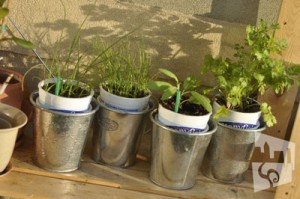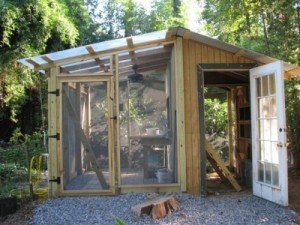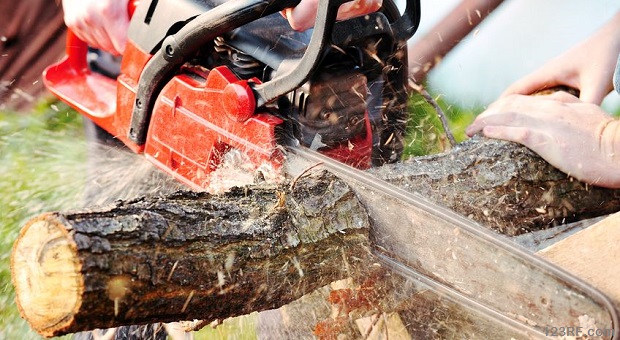Preparing for a potential SHTF scenario can often seem like a monumental task. But getting reasonably well-prepared doesn’t have to be an enormous undertaking, nor does it have to be expensive.
In fact, there are some great DIY preps that are affordable and can be accomplished in an afternoon or over the weekend, with just a bit of labor, the proper know-how, and a few minimal investments depending on the project.
Some of these preps are basically set and forget preps that require very little upkeep or input after initially being set up, while others may need varying levels of maintenance, but all these preps are quick, affordable things you can implement now. Here are some ideas to get you started:
DIY Rainwater Catchment
 A rainwater catching system can be as simple as a large funnel directing water into a holding container of 5, 10, 20 gallons or more. Be sure to check the local regulations regarding catching and storing rainwater in your area, but so long as it’s legal to do so, rainwater is a valuable resource to catch, save and use, especially during an emergency or post-SHTF.
A rainwater catching system can be as simple as a large funnel directing water into a holding container of 5, 10, 20 gallons or more. Be sure to check the local regulations regarding catching and storing rainwater in your area, but so long as it’s legal to do so, rainwater is a valuable resource to catch, save and use, especially during an emergency or post-SHTF.
Large, food-grade liquid storage containers, which are great for storing rainwater and range in size from 40 – 75 gallons to 300 or 400 gallons, can also be purchased for anywhere from $75 – $200.
In some cases you may even be able to get them for free by checking online and with local businesses. You can start catching rainwater as easily as putting one of these large containers or barrels beneath the drain of your roof’s gutters.
{adinserter emp}There are a lot of ways you can make use of rainwater now, too. You don’t have to wait for an emergency or disaster to start enjoying the benefits of watering your garden or plants with collected rainwater, for instance. Even your lawn can be irrigated with rainwater.
Add a basic level of filtration, and a few pumps or a gravity-fed system, and there are many potential uses for your rainwater in and around your home. Depending on where you live, you could potentially even use rainwater to fill a pool or top off your hot tub. Meanwhile, you’ll pay lower utility bills.
DIY Urban Container Gardening
 Where space is a constraint, I strongly recommend looking into aquaponic gardening, but aquaponics can be a bit more of an undertaking to start out with. So for the space-constrained urban prepper, container gardening is one way to take advantage of limited porch or rooftop gardening areas.
Where space is a constraint, I strongly recommend looking into aquaponic gardening, but aquaponics can be a bit more of an undertaking to start out with. So for the space-constrained urban prepper, container gardening is one way to take advantage of limited porch or rooftop gardening areas.
On its smallest scale, container gardening in window box containers can allow you to grow some basic herbs, strawberries or other dwarf plants even in the most limited space.
A 2-gallon, 3-gallon or 5-gallon bucket or container can be acquired rather cheaply or for free, and if you are starting seeds indoors you can cut a milk jug or water jug in half and use the bottom as a seedling tray, with appropriate substrate.
Smaller containers like these are suitable for growing a variety of plants, including lettuce, garlic, peppers, herbs such as basil, thyme, rosemary and mint and even tomatoes with decent results.
With a larger container, such as a 25-gallon container or a half-barrel container, you have even more options. With more space on the surface and below the soil, larger containers give you the opportunity to grow squash, larger tomatoes, zucchini, cucumber and other sprawling vegetables, as well as carrots, onions, ginger, potatoes and other root vegetables.
Alternatively, you can use a larger container to grow a blueberry bush, a trained blackberry or raspberry, or even a dwarf tree.
DIY Vegetable Oil Lamp
 When the power goes out, temporarily or more permanently, you’ll no doubt want to keep the lights on after the sun goes down.The good news is that you can stock up on various types of vegetable oil rather cheaply, specifically for use as an alternative fuel for oil lamps when the lights go out.
When the power goes out, temporarily or more permanently, you’ll no doubt want to keep the lights on after the sun goes down.The good news is that you can stock up on various types of vegetable oil rather cheaply, specifically for use as an alternative fuel for oil lamps when the lights go out.
Olive oil is especially good for this purpose, but just about any vegetable oil will do. You’ll need a container, anything from an empty tin can to a glass mason jar will do, with or without a lid depending on what you have available.
To make a vegetable oil lamp, simply pour your oil into your desired container and prepare a length of cotton, some rolled up paper towel or another suitable wick material.
You can use a lid with a hole poked through it to hold the wick, or suspend the wick in the oil using a toothpick, stick or straightened paperclip. Soak the wick thoroughly and elevate in the air above the oil, but still ½ – 2/3 immersed in it, and light it on fire. Voila, you now have a vegetable oil lamp.
DIY Hen House
 There are many affordable henhouse kits available, but if you have a hammer and nails or a good drill, and a weekend afternoon, you can build your own chicken coop, potentially even for free.
There are many affordable henhouse kits available, but if you have a hammer and nails or a good drill, and a weekend afternoon, you can build your own chicken coop, potentially even for free.
Craigslist and local retail outlets are often a good source of used pallets, empty wooden crates and other scrap wood that you can get for free or at a minimal cost. Chicken wire can be affordably sourced at a local hardware or farm supply store, along with a few hinges and a lock, and with an afternoon of labor you can have a secure chicken coop for a handful of laying hens.
DIY Fruit & Nut Orchard
This one kind of requires that you have a chunk of your own land to plant on, but if you rent land from another landowner or make a deal with a friend or neighbor there are more possibilities.
Before planting any fruit or nut trees, test the soil to ensure that it is somewhere in the 6.0 – 6.8 pH range, and ensure that there is adequate phosphorous and potassium content in the soil. Aside from yearly sampling of the soil to determine how much fertilizer to use, a handful of fruit and nut trees can be planted and left to grow largely unattended.
You will need to check on your trees a few times each season, to ensure that they are disease and pest free and to carry out any necessary pruning, but fruit and nut trees take years to reach full maturity. As a result, they are a great option for planting now in case of future need, since they take time to reach peak production.
The costs involved are fairly low, primarily the cost of seedlings and fertilizer if you need it. For the space or land-constrained, miniature or dwarf fruit and nut trees can potentially be raised in containers with decent results.
This article has been written by Gaia Rady for Survivopedia.





































































All these are good ideas. However, I find it ludicrous to worry about rainwater regulations when the SHTF. There is going to be murdering, starvation, raiding, rapine, stealing, etc. And someone is going to worry about rainwater regulations?
Dig yourself a hole at the end of your downspout. Get your 55 gallon drum, ahead of time. Bus garages will probably willingly sell you one that had antifreeze in it. You can wash most of the residue out. A good filter will take care of the rest of it, as well as boiling. Either cut the lid off, or run plastic pipe out of one end of that goes to bottom, or near bottom of barrel to connect a hose to it. Downspout gets connected to other bung hole. You may have to widen it. Dig another hold, and put a collection pot in it. Top of it would come up to the bottom of the last hole with its barrel in it. Gravity fed water collection. All of it is hidden from view. And you will have a lot more worries than worrying about regulations.
If the rain comes on my property, it is mine! The government doesn’t own it, and if it did, where is their receipt. Where is their patent, and where are their balls when they want to take it
I agree 100% “WHO” has a right to TELL ME “I” can not catch “RAIN WATER” a NATURAL GOD GIVING event!
Any ideas on how to save the rain water during winter–since the frozen water will burst the rain barrels.
If top of barrel is about 18 inches lower than ground level-it will not freeze-in NJ
Thanks for your reply, Grandpa! This is our first year with one. It is a huge clay-pot-looking thing that holds about 65 gal. My husband cut off our drain pipe to fit it. It has no lid–just a screen that sits beneath the drain pipe. My husband and I are disabled and no way could we dig a hole deep enough to cover this thing to such a depth.
If the barrel is not sealed and full the freezing water will not burst the barrel.
Empty Milk containers suspended below the surface will absorb the expansion
Rain barrels in the ground will be fairly freeze proof. Add a little insulation over the top and you can keep a fair amount of water thawed. the farther south you go the less deep you need too bury the barrel… Due to the higher frost line.
Frozen water is ICE or Snow. if ICE then store in your barrel.. it has already expanded! I have a place on Wisconsin/michigan border.. That is what I do and never burst a barrel or other storage container… just keep out of sun or bury 4 ft under ground
I would think…”put a cover over top”???? Checking the barrel isn’t rocket science.
Greetings. Lived for years as a hermit in the north woods in Michigan
U.P. In winter rain comes down as snow. I set up a 55 gallon steel drum that had a removable cover and I cleaned out and gave several coats of enamel paint to, up behind my wood stove made out of another 55 gallon steel drum. would fill the water drum with snow and ice and put the cover on it. heat from the stove melted the snow and ‘walla’ water. have to shovel a lot of snow into the barrel though to end up with it full of water. but the water will be pure. I lived on it for years and it didn’t kill me so far. and i note that my cat loved to sleep on top of the cover where it was nice and warm. Where there is a will and a need there is a way.
There is an amazing low-cost gardening breakthrough that works for fruit trees and vegetables of all kinds, on any kind of soil. Check it out at http://www.BackToEdenFilm.com
Years ago the pool man told me to throw a piece of firewood in each end of the pool so it wouldn’t break the pool when it froze. I never was there in the winter so I didn’t get a chance to test it out, just a thought.
We do a most of these on a regular basis (rain barrels, oil lamp, hen house, fruit and nut orchards).
Our Story – We sold everything, we took risks, we made sacrifices, and we started our adventure Now we enjoy a stress free Life and exciting Lifestyle… and it’s better than we ever imagined. It’s Like Winning the Lottery – moving to the Philippines made me Happier than a Millionaire
… maybe I’ll write an ebook about our experiences.
Cheers to you all!
Greg Pasden
Don’t use any container that once contained ANTIFREEZE or anything
else toxic. The risk of blindness or death just isn’t worth it….
I have an asphalt shingle roof and I am concerned about the contaminants in the roofing material getting into the water. I need some kind of pump and filter to make the water safe or potable. Any suggestions?
Hi, Stan, I do the same thing. I have rain barrels catching the water from my downspouts. At times I have filtered the water through several layers of cloth, then boiled it, or used it for cooking. It tastes fine and I’ve never gotten sick from it. If you want to be extra sure, you could do that and then take a sample to be tested. You can also buy water testing kits on line, and there are CDC, EPA and individual state Dept. of Health websites with a lot of info, if you Google “test well water.”
Another idea is that you could cover that portion of your roof from which you collect the water with plastic tarps, held down with bricks around the edges. Overlap them the same way you would shingles, so the water drips down the outside and doesn’t get under the plastic. That way the water won’t come into contact with the roofing material.
Winter growth… build a conservatory out of Geodesic Domes ($145 per kit up to 30 ft diameter… for connectors) Cover with reinforced plastic sheeting (cheep) If you double layer.. inside and outside the dome, holds heat better… Use biodigester for methane creation.. and store gas in those cheap old inflatable beds… use the gas for heat. Did a small one up north… as long as you start compressing the gas at least a month ahead of time, you should be able to go through the winter
Norb: Do you have any pictures of your dome? I’ve thought about building one, but people around here, who have tried it, do not talk too highly about them. I’d be interested in trying it though. Also, do you have links to the place you purchased plans from?
Thanks
you will need a “first flush diverter system” The first rain off of your roof is not what you want to collect at all! All of the bird poop with Girdia, dirt, resins from the sun heating the oil based solvents and products it is covered with need to rinse off and get discarded. Utube it. AND if you want the BEST least amount of parts needed and inexpensive DIY. email me [email protected] I have engineered a successful maintenance free self setting unit. The leaves and debris are spit out, no mosquitoes can get in and all of the first 40 gallons per rain gets discarded and the rest is clean. I just never got around to utubing it for others… It is something I really want to share…
Regarding. Oil lamps , can one us recycled oil in oil lamps ? If so any ideas or cautions ?
Aquaponics is a wonderful way to work a garden with little effort after major set up. We have been aqua friends for four years and love it, just remember, up front planning and budgeting
are a must. And plan overages in the budget area, but it is money well spent to do it strong,
long lasting, plan preventive maintenance often too. Let me know about my oil question please. God speed to y’all.
Jeff
Greetings. ever try burning used motor oil with a wick? smoke like the dickens and very little light. invest a little and get kerosene lights, make reflectors for them to direct the light downwards and you will find you can even read under them without getting a massive headache. soot from lights was a killer before petroleum was discovered and sold. caused lung disease bigtime among the poor that couldn’t afford candles.